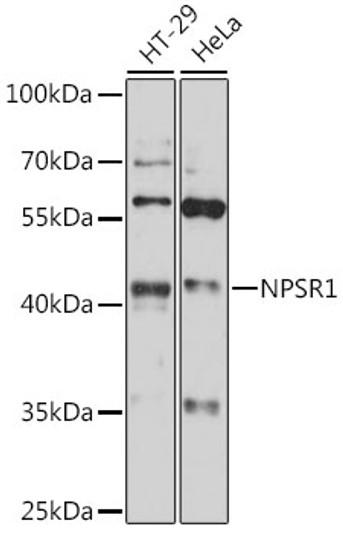| Host: | Goat |
| Applications: | Pep-ELISA |
| Reactivity: | Human |
| Note: | STRICTLY FOR FURTHER SCIENTIFIC RESEARCH USE ONLY (RUO). MUST NOT TO BE USED IN DIAGNOSTIC OR THERAPEUTIC APPLICATIONS. |
| Short Description : | Goat polyclonal antibody anti-AVPR2 (C-Term) is suitable for use in ELISA research applications. |
| Clonality : | Polyclonal |
| Conjugation: | Unconjugated |
| Isotype: | IgG |
| Formulation: | 0.5 mg/ml in Tris saline, 0.02% sodium azide, pH7.3 with 0.5% bovine serum albumin. NA |
| Purification: | Purified from goat serum by ammonium sulphate precipitation followed by antigen affinity chromatography using the immunizing peptide. |
| Concentration: | 0.5 mg/mL |
| Dilution Range: | Peptide ELISA: antibody detection limit dilution 1:64000.WB: Preliminary experiments gave an approx 250kDa band in Human Brain (Cerebellum) lysates after 0.1µg/ml antibody staining. Please note that currently we cannot find an explanation in the |
| Storage Instruction: | Store at-20°C on receipt and minimise freeze-thaw cycles. |
| Gene Symbol: | AVPR2 |
| Gene ID: | 554 |
| Uniprot ID: | V2R_HUMAN |
| Immunogen Region: | C-Term |
| Accession Number: | NP_000045.1 |
| Immunogen Sequence: | CARGRTPPSLGPQDE |
| Function | Receptor for arginine vasopressin. The activity of this receptor is mediated by G proteins which activate adenylate cyclase. Involved in renal water reabsorption. |
| Protein Name | Vasopressin V2 ReceptorV2rAvpr V2Antidiuretic Hormone ReceptorRenal-Type Arginine Vasopressin Receptor |
| Database Links | Reactome: R-HSA-388479Reactome: R-HSA-418555Reactome: R-HSA-432040Reactome: R-HSA-8856825Reactome: R-HSA-8856828Reactome: R-HSA-9036092 |
| Cellular Localisation | Cell MembraneMulti-Pass Membrane Protein |
| Alternative Antibody Names | Anti-Vasopressin V2 Receptor antibodyAnti-V2r antibodyAnti-Avpr V2 antibodyAnti-Antidiuretic Hormone Receptor antibodyAnti-Renal-Type Arginine Vasopressin Receptor antibodyAnti-AVPR2 antibodyAnti-ADHR antibodyAnti-DIR antibodyAnti-DIR3 antibodyAnti-V2R antibody |
Information sourced from Uniprot.org







